
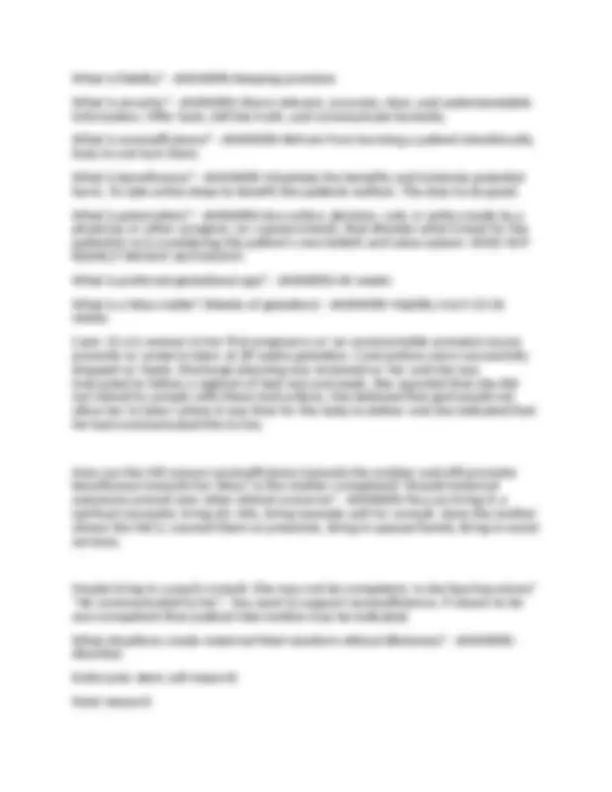
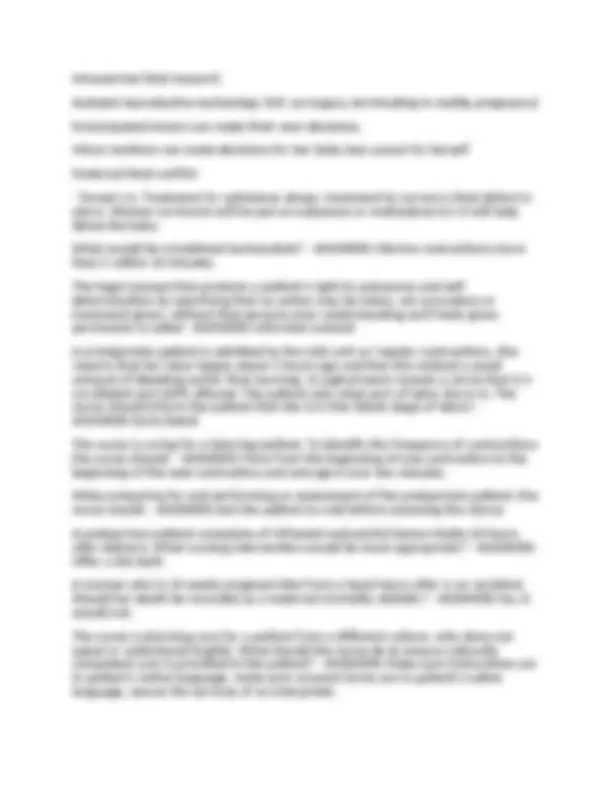
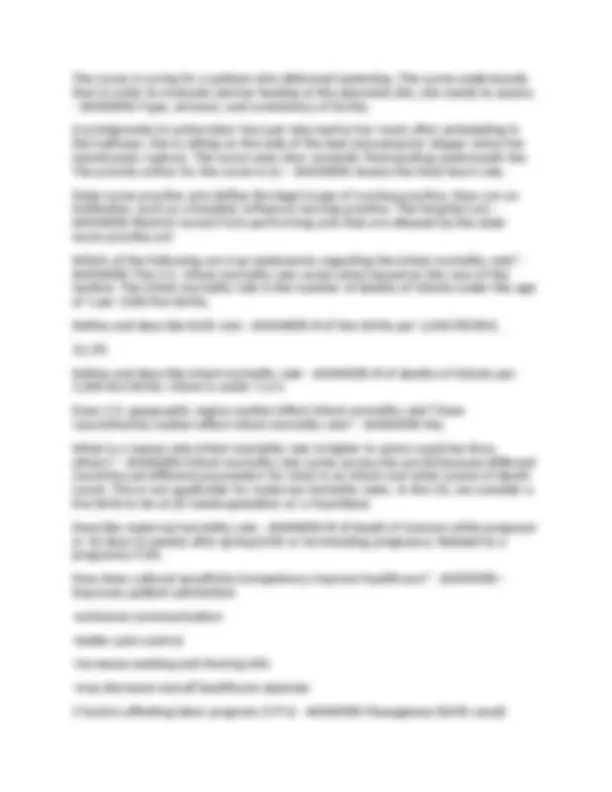
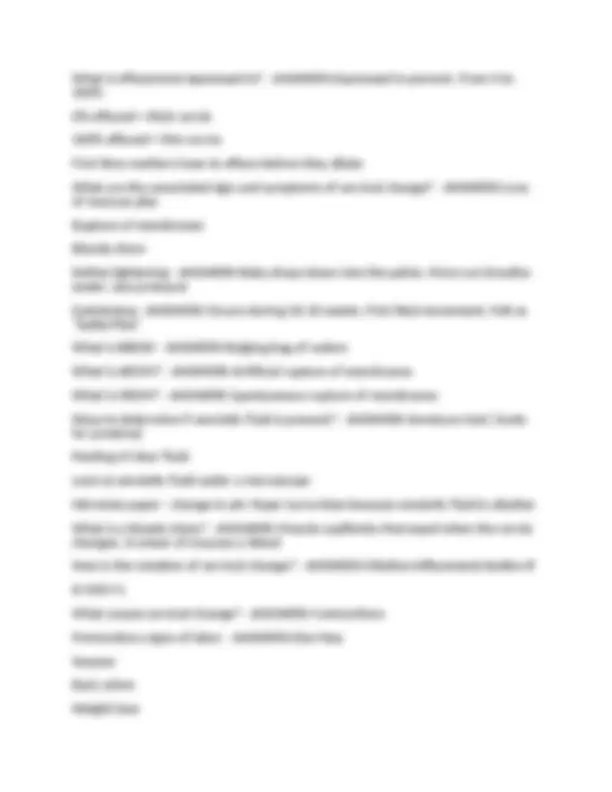
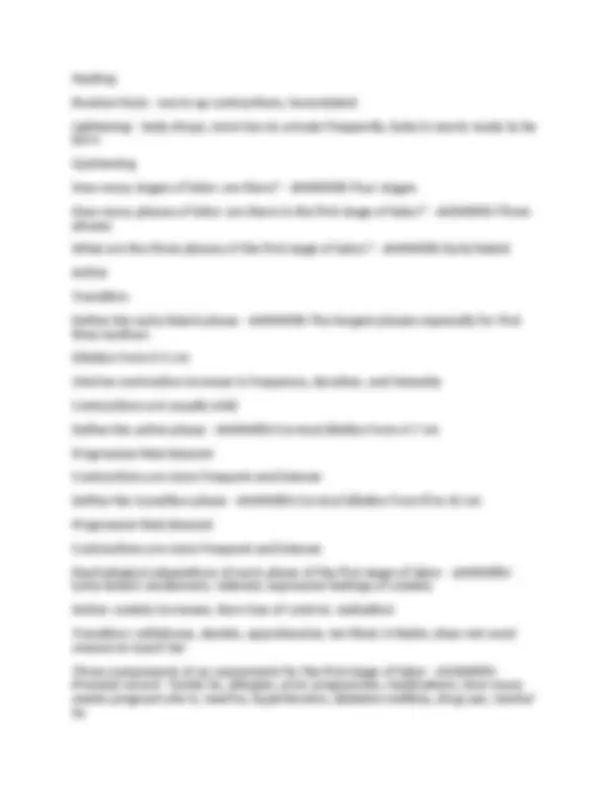
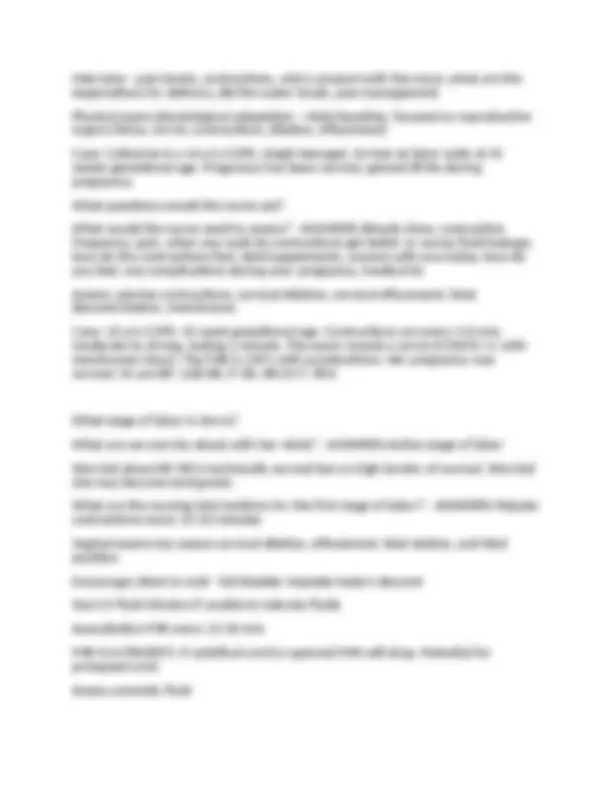
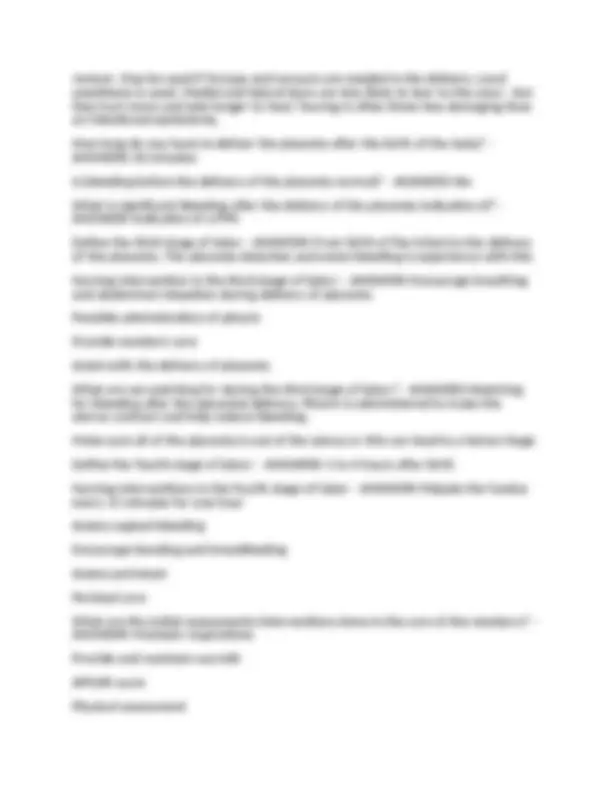
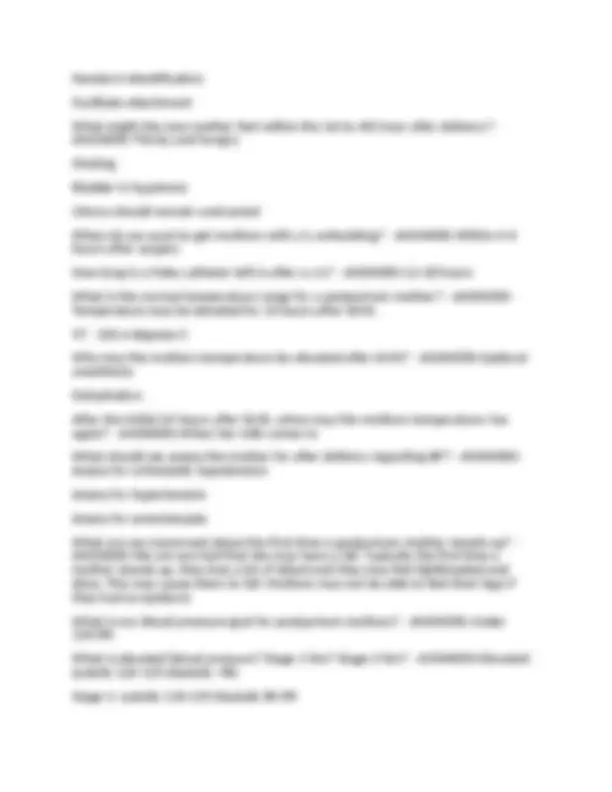
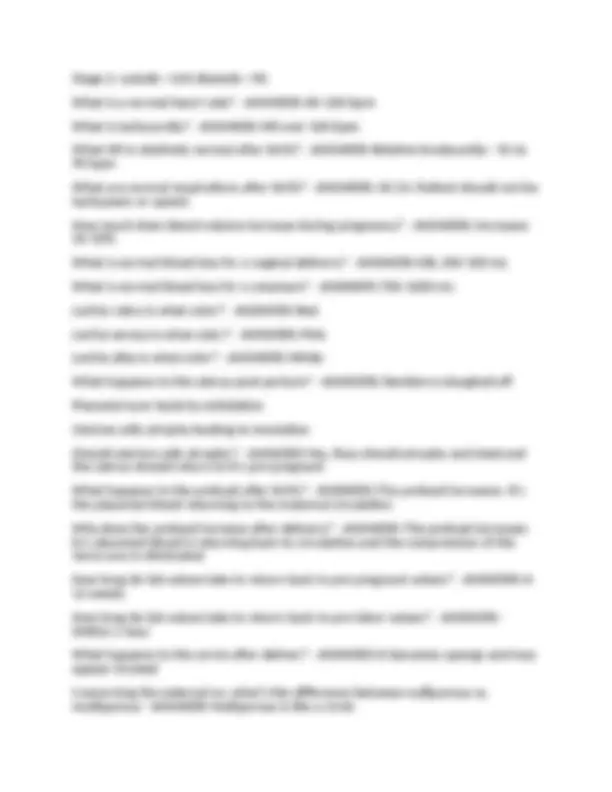


Study with the several resources on Docsity

Earn points by helping other students or get them with a premium plan


Prepare for your exams
Study with the several resources on Docsity

Earn points to download
Earn points by helping other students or get them with a premium plan
Community
Ask the community for help and clear up your study doubts
Discover the best universities in your country according to Docsity users
Free resources
Download our free guides on studying techniques, anxiety management strategies, and thesis advice from Docsity tutors
NRSG 3302 Nursing with Women and Families Module Questions With Complete Solutions 2025 Graded A+ . NRSG 3302 Nursing with Women and Families Module Questions With Complete Solutions 2025 Graded A+ .
Typology: Exams
1 / 17

This page cannot be seen from the preview
Don't miss anything!










Standards of care: why are they important? - ANSWERS-Standards of care are important because it allows for continuity across nurses, hospitals, facilities, etc. Institutional policies - ANSWERS-Are individualized. Every hospital and clinic is different and have varying policies. What is scope of practice? - ANSWERS-Defined by the state's Nurse Practice Act. Identifies the parameters within which nurses may practice. A state sets the parameters by which a nurse can practice and then an institution can further limit the nurses abilities - they can never expand What is informed consent? - ANSWERS-Nurses witness and make sure patients understand medical treatment Define negligence. How many elements are there and what are they? - ANSWERS- 4 elements. Duty to provide care The duty was breached Injury occurred Th breach of duty caused the injury Negligence leads to - ANSWERS-Malpractice and then a lawsuit Errors of (blank) can be considered negligent - ANSWERS-Omission What is a potential fifth element of negligence? - ANSWERS-Was the injury foreseeable? To prove negligence what has to be proven about the nurse? - ANSWERS-It has to be proven that the nurses failure caused the injury Case: nurse admitted a pregnant patient at 32 weeks who was reporting severe upper abdominal pain, nausea, and a headache. Her BP was 165/100 and repeated at 145/90. Her record indicated hx of elevated BP's and excess protein in her urine. Nurse notified the MD 20 min after the second BP reading and reported that the patient presented w/ abdominal pain and nausea, stated the patient's BP was 145/90 and that the patient was unable to void at this time. MD concluded that the patient had gastric disturbance from the flu. Later patient had a grand mal seizure. Why would the nurse be considered negligent? - ANSWERS-Nurse was not reporting all of the information to the MD. There were clear signs of preeclampsia. Further negligence by not knowing the sx of preeclampsia in a newborn maternal setting.
3 Main Points of Informed Consent - ANSWERS-1) must be understandable to the patient. No jargon, age appropriate speech, correct language. Include risks and benefits, success rates, and alternatives.
Intrauterine fetal research Assisted reproductive technology (IVF, surrogacy, terminating in multip pregnancy) Emancipated minors can make their own decisions. Minor mothers can make decisions for her baby but cannot for herself Maternal fetal conflict
The nurse is caring for a patient who delivered yesterday. The nurse understands that in order to evaluate uterine healing at the placental site, she needs to assess:
What does progesterone do? - ANSWERS-It is a relaxant. It keeps the uterus relaxed What can progesterone cause? - ANSWERS-Constipation Heartburn/reflux Gallstones/sluggish gallbladder Vomiting (may be from reflux) What does estrogen do? - ANSWERS-Excited uterine response What does oxytocin and prostaglandins do? - ANSWERS-Increases smooth muscle contractions. Causes contractions of the uterus and breast tissues Can effectively induce labor What medication stops contractions in preterm labor? - ANSWERS-Indocin Indocin does what? - ANSWERS-It is an anti prostaglandin. It stops contractions in preterm labor Frequency of uterine contractions - ANSWERS-The timing from the beginning of one contraction to the start of another contraction What is tachysystole? - ANSWERS-More than 5 contractions in 10 minutes. What can tachysystole result in? - ANSWERS-Deoxygenated blood for the baby. Duration of uterine contractions - ANSWERS-Beginning to the end of one contraction. Intensity of uterine contractions - ANSWERS-Strength of the contraction What is the best way to determine the intensity of contractions? - ANSWERS- Palpate the uterus/belly and feel the contraction. What does an external fetal monitor (EFM) show you? - ANSWERS-It will show you the duration and frequency of contractions but won't indicate intensity. What would a mild contraction feel like? - ANSWERS-A squishy chin What would a moderate contraction feel like? - ANSWERS-The tip of a nose What would a strong contraction feel like? - ANSWERS-A forehead Define dilation - ANSWERS-The cervical is opening up What is dilation expressed in? - ANSWERS-In centimeters. From 0 to 10 cm. Women are ready to push at 10 Define effacement - ANSWERS-Thinning of the cervix
What is effacement expressed in? - ANSWERS-Expressed in percent. From 0 to 100% 0% effaced = thick cervix 100% effaced = thin cervix First time mothers have to efface before they dilate What are the associated sign and symptoms of cervical change? - ANSWERS-Loss of mucous plus Rupture of membranes Bloody show Define lightening - ANSWERS-Baby drops down into the pelvis. Mom can breathe easier. Less pressure Quickening - ANSWERS-Occurs during 16-20 weeks. First fetal movement. Felt as "butterflies" What is BBOW - ANSWERS-Bulging bag of waters What is AROM? - ANSWERS-Artificial rupture of membranes What is SROM? - ANSWERS-Spontaneous rupture of membranes Ways to determine if amniotic fluid is present? - ANSWERS-Amnisure test ( looks for proteins) Pooling of clear fluid Look at amniotic fluid under a microscope Nitrosine paper - change in pH. Paper turns blue because amniotic fluid is alkaline What is a bloody show? - ANSWERS-Muscle capillaries that expel when the cervix changes. A smear of mucous-y blood How is the notation of cervical change? - ANSWERS-Dilation/effacement/station # 6/100/+ What causes cervical change? - ANSWERS-Contractions Premonitory signs of labor - ANSWERS-Diarrhea Nausea Back aches Weight lose
Interview - pain levels, contractions, who's present with the mom, what are the expectations for delivery, did the water break, pain management Physical exam/physiological adaptation - vitals/baseline, focused on reproductive organs (fetus, cervix, contractions, dilation, effacement) Case: Catherine is a 14 y/o G1P0, single teenager. Arrives at labor suite at 41 weeks gestational age. Pregnancy has been normal, gained 28 lbs during pregnancy. What questions would the nurse ask? What would the nurse need to assess? - ANSWERS-Bloody show, contraction frequency, pain, when you walk do contractions get better or worse,fluid leakage, how do the contractions feel, diet/supplements, anyone with you today, how do you feel, any complications during your pregnancy, medical hx Assess: uterine contractions, cervical dilation, cervical effacement, fetal descent/station, membranes Case: 14 y/o G1P0. 41 week gestational age. Contractions are every 5-6 min, moderate to strong, lasting 1 minute. The exam reveals a cervix 6/100%/-1; with membranes intact. The FHR is 130's with accelerations. Her pregnancy was normal. VS are BP: 128/68, P: 84, RR:20 T: 98. What stage of labor is she in? What are we worries about with her vitals? - ANSWERS-Active stage of labor Worried about BP. RR is technically normal but on high border of normal. Worried she may become tachypneic. What are the nursing interventions for the first stage of labor? - ANSWERS-Palpate contractions every 15-30 minutes Vaginal exams too assess cervical dilation, effacement, fetal station, and fetal position Encourage client to void - full bladder impedes baby's descent Start IV fluid infusion if unable to tolerate fluids Auscultation FHR every 15-30 min FHR IS A PRIORITY. If umbilical cord is ruptured FHR will drop. Potential for prolapsed cord. Assess amniotic fluid
Comfort measures What is a prolapsed cord? Why is it dangerous? - ANSWERS-Prolapsed cord is when the cord comes out before the baby. It can cut off the oxygen/blood supply What are the three components to the evaluation of fetal monitoring? - ANSWERS-Determine the baseline Determine the baseline variability Determine whether there are periodic changes Where is FHR best heard? - ANSWERS-Best heard is through the baby's back. Where you hear FHR is a good indicator of fetal positioning. How long does FHR have to monitored to determine a baseline? - ANSWERS- minutes to determine mean FHR What is the normal range for FHR? - ANSWERS-Normal is 110-160 bpm What is fetal tachycardia? - ANSWERS-Anything over 160 bpm. Accelerated HR What can cause fetal tachycardia? - ANSWERS-Fever or stress What is fetal bradycardia? - ANSWERS-Anything lower than 110 bpm. Decelerated FHR What does baseline variability tell us about the fetus? - ANSWERS-It is a reliable indicator of fetal cardiac and neurological function What are the four markers or measurements of fetal hr? - ANSWERS-Absent - VERY concerning. Amplitude is undecided. Minimal - seen when the baby is asleep or when narcotized. Amplitude range detectable - <5 bpm Moderate - NORMAL. Amplitude range 6 to 25 bpm Marked - HR is all over the place. Baby could be very active or could be a sign of HYPOXIA. Amplitude >25 bpm What phase are sedatives used in? - ANSWERS-Early/latent phase What purpose do sedatives serve? - ANSWERS-Relaxation and sleep What is a common sedative? - ANSWERS-Ambien What phase are H-1 receptor antagonists used in? - ANSWERS-Early/latent phase What purpose do H1-receptor antagonists serve? - ANSWERS-Sedative, antiemetic What are two common H1-receptor antagonists? - ANSWERS-Phenergan and
rectum. May be used if forceps and vacuum are needed in the delivery. Local anesthesia is used. Medial and lateral tears are less likely to tear to the anus - but they hurt more and take longer to heal. Tearing is often times less damaging than an intentional episiotomy. How long do you have to deliver the placenta after the birth of the baby? - ANSWERS-30 minutes Is bleeding before the delivery of the placenta normal? - ANSWERS-Yes What is significant bleeding after the delivery of the placenta indicative of? - ANSWERS-Indicative of a PPH Define the third stage of labor - ANSWERS-From birth of the infant to the delivery of the placenta. The placenta detaches and some bleeding is experience with this. Nursing intervention in the third stage of labor: - ANSWERS-Encourage breathing and abdominal relaxation during delivery of placenta Possible administration of pitocin Provide newborn care Assist with the delivery of placenta What are we watching for during the third stage of labor? - ANSWERS-Watching for bleeding after the placental delivery. Pitocin is administered to make the uterus contract and help reduce bleeding. Make sure all of the placenta is out of the uterus or this can lead to a hemorrhage Define the fourth stage of labor: - ANSWERS-1 to 4 hours after birth Nursing interventions in the fourth stage of labor - ANSWERS-Palpate the fundus every 15 minutes for one hour Assess vaginal bleeding Encourage bonding and breastfeeding Assess perineum Perineal care What are the initial assessments/interventions done in the care of the newborn? - ANSWERS-Maintain respirations Provide and maintain warmth APGAR score Physical assessment
Newborn identification Facilitate attachment What might the new mother feel within the 1st to 4th hour after delivery? - ANSWERS-Thirsty and hungry Shaking Bladder is hypotonic Uterus should remain contracted When do we want to get mothers with c/s ambulating? - ANSWERS-Within 4- hours after surgery How long is a Foley catheter left in after a c/s? - ANSWERS-12-18 hours What is the normal temperature range for a postpartum mother? - ANSWERS- Temperature may be elevated for 24 hours after birth. 97 - 100.4 degrees F. Why may the mothers temperature be elevated after birth? - ANSWERS-Epidural anesthesia Dehydration After the initial 24 hours after birth, when may the mothers temperature rise again? - ANSWERS-When her milk comes in What should we assess the mother for after delivery regarding BP? - ANSWERS- Assess for orthostatic hypotension Assess for hypertension Assess for preeclampsia What are we concerned about the first time a postpartum mother stands up? - ANSWERS-We are worried that she may have a fall. Typically the first time a mother stands up, they lose a lot of blood and they may feel lightheaded and dizzy. This may cause them to fall. Mothers may not be able to feel their legs if they had an epidural. What is our blood pressure goal for postpartum mothers? - ANSWERS-Under 120/ What is elevated blood pressure? Stage 1 htn? Stage 2 htn? - ANSWERS-Elevated: systolic 120-129 diastolic <80. Stage 1: systolic 130-139 diastolic 80-
Muliparous is like a lateral slit Why is occiput posterior painful? - ANSWERS-Because the baby is rubbing against the sacrum and causes additional pressure? How do you help a mother who has an occiput posterior positioned baby? - ANSWERS-Apply counter pressure to the sacrum and help them reposition (hands & knees) Concerning the vagina how does it appear after delivery? - ANSWERS-It will be edematous, bruised, and may have lacerations Regarding the breasts and lactation, what happens to the hormone levels? - ANSWERS-Estrogen and progesterone decrease. How do the breast's become ready for lactation after delivery? - ANSWERS-They begin to produce milk via prolactin What happens to ovulation/menstruation after delivery? - ANSWERS-It resumes. In nonbreast feeding moms they ovulate in five weeks and menstruate in 7- weeks. Does breastfeeding inhibit ovulation? - ANSWERS-Yes it does. For 3 or more months. It reduces the risk of pregnancy but is not a formal method of contraception What does prolactin do in regard to breast feeding? - ANSWERS-It causes milk production What does oxytocin do in regard to breast feeding? - ANSWERS-Let-down reflex. Causes contraction of muscles. Define postpartum diuresis - ANSWERS-In the first 12-24 hours after birth, women expel 2-3 liters of fluid. They lose about 5 pounds. What is happening to the hormones in regard to postpartum diuresis? - ANSWERS-Aldosterone production decreases Sodium retention decreases And urinary production increases What happens to the bladder capacity after birth? - ANSWERS-It increases. There is more room because the baby is gone What are the implication of increased bladder capacity - ANSWERS-Urinary stasis - there is a decrease in bladder feeling. There is swelling and bruising in the tissues around the urethra. Not being able to void, or not feeling the ability to void, will move and displace the uterus. What happens to the bowel pattern after delivery? - ANSWERS-The bowels will be
sluggish. You risk constipation Episiotomy, lacerations, or hemorrhoids may delay elimination What can be prescribed to patients to help them with elimination? - ANSWERS- They should typically be prescribed a fiber supplement What are the effects of relaxin - ANSWERS-Relaxes ligaments in the pelvis and soften the cervix What happens to the musculoskeletal system after delivery? - ANSWERS-Becomes lose and flabby but responds to exercise. Diastasis recti abdominis What happens to the integumentary system after delivery? - ANSWERS-Perineum may be edematous with bruising Lacerations or episiotomy Striae What happens to the neurologic/immune system after delivery? - ANSWERS- Neurologic - women may have a headache (different from a spinal headache due to the fluid shift) May also have carpal tunnel from the amount of fluids given Immune - rubella. Can be teratogenic. Best time to give vaccine is right after birth. Rh incompatibility. Treat mom with rhogam before and after delivery. What is the post partum assessment - ANSWERS-BUBBLEHE Breasts Uterus Bladder Bowel Lochia Episiotomy Homan's sign/hemorrhoids Emotions Initiating a post partum assessment, what do you do - ANSWERS-Identify yourself, identify patient and baby, wash hands before and after exam. Wear gloves - check for latex allergies